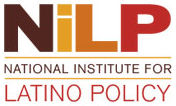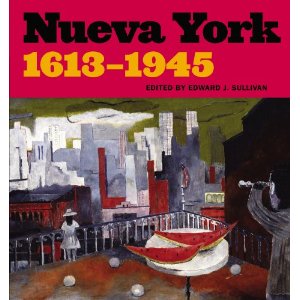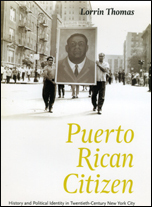 Latinos in New York: A Review of Recent Literature
Latinos in New York: A Review of Recent Literature
By Angelo Falcón (September 20, 2010)
 These past few weeks a number of projects came to fruition almost simultaneously that thoughtfully reflect on the Latino experience in New York City (or is it the New York City experience with Latinos?). Hispanic New York: A Sourcebook (Columbia University Press), edited by Claudio Iván Remeseira just hit the bookshelves. This was followed by the current Museo del Barrio exhibit and its catalog, Nueva York 1613-1945 , edited by Edward J. Sullivan (New York Historical Society in association with Scala Publishers). And just before these came out, last month saw the more subdued publication of Puerto Rican Citizen: History and Political Identity in Twentieth Century New York City (University of Chicago Press), by Lorrin Thomas.
These past few weeks a number of projects came to fruition almost simultaneously that thoughtfully reflect on the Latino experience in New York City (or is it the New York City experience with Latinos?). Hispanic New York: A Sourcebook (Columbia University Press), edited by Claudio Iván Remeseira just hit the bookshelves. This was followed by the current Museo del Barrio exhibit and its catalog, Nueva York 1613-1945 , edited by Edward J. Sullivan (New York Historical Society in association with Scala Publishers). And just before these came out, last month saw the more subdued publication of Puerto Rican Citizen: History and Political Identity in Twentieth Century New York City (University of Chicago Press), by Lorrin Thomas.
 These are welcome developments, since it was about 14 years ago that the last comprehensive attempt to examine the Latino community in New York was published as Latinos in New York: Communities in Transition (University of Notre Dame Pres, 1996), edited by Gabriel Haslip-Viera and Sherrie L. Baver. Among other things it featured a much-cited lead article by Haslip-Viera, "The Evolution of the Latino Community in New York City: Early Nineteen Century to the Present."
These are welcome developments, since it was about 14 years ago that the last comprehensive attempt to examine the Latino community in New York was published as Latinos in New York: Communities in Transition (University of Notre Dame Pres, 1996), edited by Gabriel Haslip-Viera and Sherrie L. Baver. Among other things it featured a much-cited lead article by Haslip-Viera, "The Evolution of the Latino Community in New York City: Early Nineteen Century to the Present."
There was also the more recent and quirky reader, Mambo Montage: The Latinization of New York, edited by Agustín Laó-Montes and Arlene Dávila (Columbia University Press, 2001), handicapped, unfortunately, by a sometimes indiscernible and confusing post-modern narrative. But be that as it may, it is interesting that despite the size of New York's Latino population and the large number of research universities and institutions that inhabit it, there has been so little attention paid to it in at least the last decade and half. The one exception pehaps being Inheriting the City: The Children of Immigrants Come of Age, edited by Philip Kasinitz, John M. Mollenkopf, Mary C. Waters and Jennifer Holoaway (Harvard University Press, 2008), which takes a comprehensive look at 2nd and 3rd generation Latinos and other immigrants in the New York metropolitan area.
Besides struggling against images of themselves as "foreigners," Latinos in New York have had to also deal with the notion that they all just arrived to the city the other day. Cast as newcomers, their reality is portrayed as a casualty of recency, the resulting lack of assimilation and the illegality of their status. Columbia journalism professor Claudio Remeseira's Hispanic New York provides historical overviews of a Latino presence in New York that is centuries old, including the writings about New York of such authors as José Martí, Bernardo Vega, Walt Whitman and profiling such figures as Archer Milton Huntington and others. This reader also contains a very healthy representation of Puerto Rican writers, acknowledging the unique role that this community has played in defining this Hispanic New York.
With a wide range of essays on: People and Communities; Perspectives on Race, Ethnicity, and Religion; Language and Literature: A Bilingual Tradition; and Music and Art, Latino, Latin American, American, Remeseira brings together a broad and largely cultural studies view of the Latino experience in New York and how it shaped and was shaped by the city. It should prove to be an invaluable and highly accessible resource for teachers of Latino and New York City studies.
 As Hispanic New York provides useful perspectives on the breadth and length of the Latino experience in New York City, CUNY professor Mike Wallace and his team extend and deepen that history with their exhibit and accompanying catalog, Nueva York 1613-1945. The catalog, edited by NYU professor Edward J. Sullivan, is beautifully illustrated and presents a wealth of historical knowledge on the Latino community, nicely framed by Wallace's lead essay, "Nueva York: The Back Story --- New York City and the Spanish-Speaking World from Dutch Days to the Second World War." There are description of this early period of intense international commercial relations that were "globalization" before the term became popular relatively recently. I recall Wallace lambasting globalization scholar Saskia Sassen at a conference a few years ago for trying to present it as something new when, in fact, he argued it was a very old phenomenon. He was kind of hilariously obnoxious about it, but this essay in Nueva York provides a nice context for the rage he hoisted upon poor Saskia at the time.
As Hispanic New York provides useful perspectives on the breadth and length of the Latino experience in New York City, CUNY professor Mike Wallace and his team extend and deepen that history with their exhibit and accompanying catalog, Nueva York 1613-1945. The catalog, edited by NYU professor Edward J. Sullivan, is beautifully illustrated and presents a wealth of historical knowledge on the Latino community, nicely framed by Wallace's lead essay, "Nueva York: The Back Story --- New York City and the Spanish-Speaking World from Dutch Days to the Second World War." There are description of this early period of intense international commercial relations that were "globalization" before the term became popular relatively recently. I recall Wallace lambasting globalization scholar Saskia Sassen at a conference a few years ago for trying to present it as something new when, in fact, he argued it was a very old phenomenon. He was kind of hilariously obnoxious about it, but this essay in Nueva York provides a nice context for the rage he hoisted upon poor Saskia at the time.
The Nueva York catalog includes essays by Cathy Matson, Lisando Pérez, Virginal Sánchez Korrol, Carmen Boullosa (Mike Wallace's wife), Katherin E. Manthorne, Richard I. Kagan, James D. Fernandez, Anna Indych-Lopez and Juan Flores. Since the so-called Great Migration of Puerto Ricans to New York City occurred after 1945, there were some worries that this exhibit would give the Puerto Rican presence in the city short shrift. However, it appears that great pains were taken to be inclusive of this experience, making the exhibit experience and the coverage of the catalog that much more satisfying and accurate.
The exhibit, which opened at the Museo del Barrio in Manhattan last Friday, was highlighted by an installation by Antonio Martorell, "From Here to There," made to resemble the airplanes that brought many Puerto Ricans to New York. One enters as a passenger to view the short documentary, Nueva York, by Rick Burns (yes, Ken Burns' brother!) that focuses on the Puerto Rican experience in the city, as well as that of other Latinos. Much of it consists of thoughtful commentary by Puerto Rican journalists Ray Suarez and Juan Gonzalez, and sociologist Rob Smith, but also some strangly vacuous observations by writer and CCNY professor Carmen Boullosa.
Rumor has it that a longer version of this film will appear as a PBS documentary (it was disappointing that the Museo did not have DVDs of this film on sale in their gift shop). The rest of the exhibit seemed a bit old fashioned and static in its presentation, but then, I'm not much of a museum guy. And then there was that God awful review of the exhibit by Edward Rothstein in the New York Times, in which he unfairly criticizes the film, which led me to believe that he only stayed for the first few minutes of it.
 There are times when things come up that remind you that you are getting old, really old. This was the case with Lorrin Thomas' Puerto Rican Citizen. Back in 1984 (yes, 1984!), I had published a little essay, "A History of Puerto Rican Politics in New York City: 1860s to 1945" in the book Puerto Rican Politics in Urban America, edited by James Jennings and Monte Rivera (Greenwood Press, 1984). Looking back on it, it was a reckless attempt by me to play historian and make the case that the Puerto Rican experience with New York City politics was much longer than had been generally acknowledged at the time. I lamented the lack of a general history of the Puerto Rican community. Well, 26 years later, Thomas' Puerto Rican Citizen comes as close to anything else toward filling that gap.
There are times when things come up that remind you that you are getting old, really old. This was the case with Lorrin Thomas' Puerto Rican Citizen. Back in 1984 (yes, 1984!), I had published a little essay, "A History of Puerto Rican Politics in New York City: 1860s to 1945" in the book Puerto Rican Politics in Urban America, edited by James Jennings and Monte Rivera (Greenwood Press, 1984). Looking back on it, it was a reckless attempt by me to play historian and make the case that the Puerto Rican experience with New York City politics was much longer than had been generally acknowledged at the time. I lamented the lack of a general history of the Puerto Rican community. Well, 26 years later, Thomas' Puerto Rican Citizen comes as close to anything else toward filling that gap.
Based on her doctoral dissertation, Thomas provides a rich history of the Puerto Rican community in New York City. Playing off of the path-breaking Memoirs of Bernardo Vega, as I did more than a quarter century ago, but with much more depth, detail, accuracy, research and style than I ever came close to, she tells the story of the Puerto Rican experience from a framework that gives life to the often vague notion of "cultural citizenship." I have but praise for this book, fulfilling as it does a wish I made so long ago. It is nearly flawless, except for its perhaps overly theoretical intro (it's a dissertation after all, I guess), the sketchiness of its treatment of the more recent period (no doubt written under pressure from the publisher) and its disproportionate focus on the Young Lords. But it is the early history that she makes sing that counts most to me. Puerto Rican Citizen is a major accomplishment and contribution to the historiography of the Latino experience in New York and the United States.
There's that old saying, "When it rains, it pours," Well, those interested in the Latino experience in New York can now say they are completely soaked.
